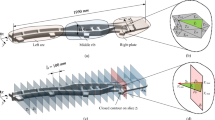Abstract
Preform design is an important aspect of the research and development of the forging processes, which plays a key role in improving product quality, such as improving material filling capacity and reducing forming loads. In industry, preforms are generally designed by the iterative trial-and-error approach. This approach, however, leads not only to the increase of tool cost but also to prolonged production time. On the basis of the minimum energy principle and the minimum resistance law, a new approach by means of 3D electrostatic field simulation and geometric transformation is proposed in this paper to design the preform shape. Two axisymmetric (a disk and a blind-hole) forgings and a long-axis part are used to demonstrate this method, and finite element package DEFORM 3D is used to simulate the forming process for the purpose of verifying the validity and effectiveness of this approach.
Similar content being viewed by others
References
Gao T, Yang H, Liu YL (2008) Influence of dynamic boundary conditions on preform design for deformation uniformity in backward simulation. J Mater Process Technol 197:255–260
Kong TF, Chan LC, Lee TC (2008) Numerical and experimental investigation of preform design in non-axisymmetric warm forming. Int J Adv Manuf Technol 37:908–919
Park JJ, Rebelo N, Kobayashi S (1983) A new approach to preform design in metal forming with the finite element method. Int J Mach Tool Des Res 23:71–79
Sheu JJ, Yu CH (2009) Preform and forging process designs based on geometrical features using 2D and 3D FEM simulations. Int J Adv Manuf Technol 44:244–254
Han CS, Grandhi RV, Srinvasan R (1993) Optimal design of forging die shapes using nonlinear finite element analysis. AIAA J 31:774–781
Vazquez V, Altan T (2000) Die design for flashless forging of complex parts. J Mater Process Technol 98:81–89
Zhao X, Zhao G, Wang G, Wang TH (2002) Preform die shape design for uniformity of deformation in forging based on preform sensitivity analysis. J Mater Process Technol 128:25–32
Shim H (2003) Optimal preform design for the free forging of 3D shapes by the sensitivity method. J Mater Process Technol 134:99–107
Nagarajan T, Grandhi RV (2005) Multi-level design process for 3-D preform shape optimization in metal forming. J Mater Process Technol 170:421–429
Sedighi M, Tokmechi S (2008) A new approach to preform design in forging process of complex parts. J Mater Process Technol 197:314–324
Haluk H, Sonme FO (2009) Optimum shape design of die and preform for improved hardness distribution in cold forged parts. J Mater Process Technol 209:1538–1549
Lee SR, Lee YK, Park CH, Yang DY (2002) A new method of preform design in hot forging by using electric field theory. Int J Mech Sci 44:773–792
Wang XN, Li FG (2009) A quasi-equipotential field simulation for preform design of P/M superalloy disk. Chin J Aeronaut 22:81–86
Li C, Li FG, Zhang Y, Li CL, Liu YH (2005) Reverse educing method of bulge-blank based on equipotential field. Jixie Gongcheng Xuebao 41:127
Herarn D, Baker MP (1986) Computer graphics. Prentice-Hall, Englewood Cliffs
ASM International Handbook Committee (1988) Metals handbook: forming and forging. ASM International, Materials Park
Hsiang SH, Ho HL (2005) A study on the warping problems of thin flange under the radial forging processes by FEM and experiments. Int J Adv Manuf Technol 26:47–55
Ma Q, Lin ZQ, Yu ZQ (2009) Prediction of deformation behavior and microstructure evolution in heavy forging by FEM. Int J Adv Manuf Technol 40:253–260
Li QH, Li FG, Wan Q, Li MQ (2007) Finite element simulation of superplastic isothermal forging process for nickel-base PM superalloy. Mater Sci Forum 551–552:297
Ji GL, Li FG, Li QH, Li HQ, Li Z (2010) High-temperature deformation constitutive relationship and microstructure evolution in Aermet100 steel. Cailiao Rechuli Xuebao 31:83–88
Cai J, Li FG, Liu TY, Chen B, He M (2011) Constitutive equations for elevated temperature flow stress of Ti–6Al–4V alloy considering the effect of strain. Mater Des 32:1144–1151
Author information
Authors and Affiliations
Corresponding author
Rights and permissions
About this article
Cite this article
Cai, J., Li, F. & Liu, T. A new approach of preform design based on 3D electrostatic field simulation and geometric transformation. Int J Adv Manuf Technol 56, 579–588 (2011). https://doi.org/10.1007/s00170-011-3216-7
Received:
Accepted:
Published:
Issue Date:
DOI: https://doi.org/10.1007/s00170-011-3216-7



